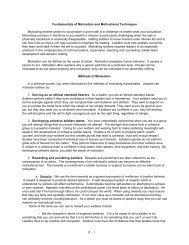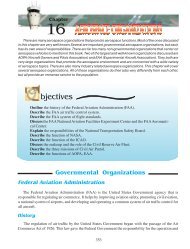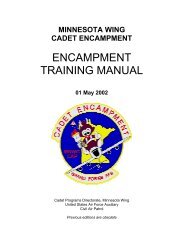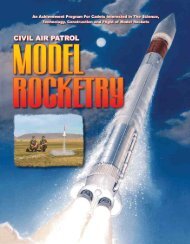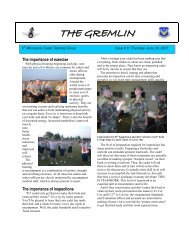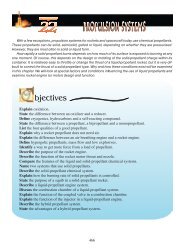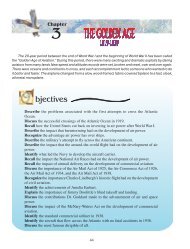mandates or resolutions that would affect our proposedoperations or interests. Nongovernmental organizationsmay also be willing to help—or perhaps require help.Each of these concerns is legitimate and makes the internationalenvironment the most challenging and unfamiliarof them all.This framework for the components of the strategic environmentis simple in design yet complicated in practice.Most US government personnel are intimately familiarwith the national security and military environmentssince they are linked (i.e., military strategy follows directlyfrom national security decisions). But strategic leadersmust recognize that the two greatest influences on theirdecisions come from the domestic and international environments.To lead effectively, they should use what ismost familiar and be able to synthesize what influencestheir strategic decisions.The four components of the strategic environment presenta challenge for strategic leaders. The national securityenvironment, with its many taskmasters, will drive bothstrategic decisions and military strategy. Leaders will feelgreat influence from the familiar domestic environmentand must have its support for strategic action. Further,strategic leaders can be surprised and their decisionsthwarted if they fail to understand the international environmentsufficiently. Knowing the disparate componentsof the strategic environment is the first step in graspingstrategic leadership. Understanding the nature of thestrategic environment and strategic decisions is thesecond step.NATURE OF THE STRATEGIC ENVIRONMENTThe strategic-leadership environment differs from theclimate at lower levels of leadership. We should view thenature of this environment both broadly—examiningconsequential decisions and changes in performancerequirements—and narrowly.CONSEQUENTIAL DECISIONSBy nature, strategic leadership requires consequentialdecision making. All decisions have consequences, but inthe strategic context, they take on a different character—specifically, they are planned, generally long term, costly,and profound.Consequential decisions occur only at the higher levelswithin organizations. Generally, decision makers in thetop 20 percent of the organization—the people who haveultimate control of resources—plan and execute suchdecisions. They also think out the implications of theirdecisions in advance. That is to say, the decision makersanalyze and evaluate the possible, probable, and necessaryramifications of a decision beforehand. Some peopleargue that the sergeant on patrol in Kosovo or the bombercrew over Afghanistan can make strategic decisions in asplit second and thus become strategic decision makers.No doubt, armed forces and government officials do makelethal, destructive, and sometimes regrettable decisions.However, these determinations are considered tacticalopportunities or, worse, operational blunders rather thanplanned, consequential decisions. Planning becomesmore important when one considers the long-term natureof consequential decisions.Such decisions require years to play out. Indeed, in mostcases strategic decision makers may not be around to witnessthe actual consequences of the decision, making it allthe more essential that they carefully consider all implicationsbefore taking action. Clearly, a hasty consequentialdecision can become very costly.One may classify these attendant costs as either immediateor mortgaged. For instance, some consequential decisions—suchas declaring war or beginning hostilities—canhave immediate costs or effects. The cost in lives couldbecome very heavy in a matter of days. World economiccosts could mount within weeks while markets collapsewithin hours. Mortgaged costs of consequential decisions,however, refer to lost opportunities and “sunk” costs. Wesee such consequences, for example, when organizationscommit to huge purchases for weapons systems over adecade-long time frame. Of course in the strategic environment,costs are measured not only in dollars but alsoin influence (e.g., the costs of supporting one nation overanother or the costs of not supporting a particular position).Many times, the decision becomes a matter of sunkcosts—gone forever with no chance of recovery. Up to thispoint, we have considered only the negative effects ofcosts on consequential decisions. Suffice it to say thatmany consequential decisions have the aim of decreasing,avoiding, or postponing costs. In fact, some of the leastcostly consequential decisions turn out to be the mostprofound (e.g., expanding free-trade agreements and theNA<strong>TO</strong> alliance, reducing the number of nuclear arms, etc.).Consequential decisions are profound because they havethe potential to create great change, lead trends, alter thecourse of events, make history, and initiate a number ofwide-ranging effects. They can change societies andadvance new disciplines. Most importantly, an entireorganization, a segment of society, a nation, or humanityin general recognizes such decisions as profound.12
PERFORMANCE REQUIREMENTSThe stratified systems theory of T. Owen Jacobs andElliott Jaques classifies the performance requirements forleaders in organizations as direct, general, and strategic(in military parlance: tactical, operational, and strategic,respectively). 2 Distinct elements define the leadershipenvironment within each level. Unmistakable differencesamong the three levels include complexity, time horizon,and focus.Most people spend their careers leading at the direct ortactical level (squadron or battalion commander, branchchief, or below). In this environment, the leader interactsdirectly with the same people every day by maintaininga direct span of control, all the while executing plans,following policies, and consuming resources with adefined goal in mind. The time horizon is very short—normally less than one year. At the direct level of leadership,communications generally occur within the sameorganization and focus exclusively on the internal audience.Because leaders spend more time at this level than anyother, it becomes familiar and comfortable.Some leaders, however, will mature and move to the generalor operational level, where performance requirementsbegin to change. Direct leadership diminishes as the spanof control shrinks. At this level, leaders develop plans,write some policies, and allocate resources among subordinateorganizations. The time horizon also increases—toas much as five years. Operational leaders begin to shiftthe focus of communication and energy outside theorganization, recognizing and questioning how the externalenvironment will affect their organizations. Groupcommanders, brigade commanders, and division chiefsrepresent this general, analytic level of leadership.From the perspective of budding strategic leaders, performancerequirements for the strategic level change themost and are the least familiar. The power of influencebecomes more important than the power of the position.Conceptual ability and communications become essential.Both focus not only on how the external environment willaffect the organization, but also—and more importantly—on how the organization can influence that environment.The most challenging of the performance requirements isthe time frame for making decisions, which can extend to20 years and beyond. The leader at this level must think interms of systems and use integrative thinking—the abilityto see linkages and interdependencies within large organizations(or systems) so that decisions in one system willnot adversely affect another system. 3 The challenges aregreat, the stakes are high, and the performance requirementsare stringent.VOLATILITY, UNCERTAINTY, COMPLEXITY,AND AMBIGUITYFraming the nature of the strategic environment in abroad context helps us understand the magnitude of thechallenge. Strategic leaders operate in an environment thatdemands unique performance requirements for makingconsequential decisions. If we look more closely at thisenvironment, we discover four characteristics that definethe challenge to strategic leadership in a narrow sense:volatility, uncertainty, complexity, and ambiguity. 4Now that the world is no longer bipolar, the strategiclandscape has become more volatile. Violence erupts inthe most unlikely places and for seemingly innocuousreasons. The last few years have given us a glimpse of thisvolatility: ethnic cleansing in Bosnia and Kosovo, war andterrorism in the Middle East, and terrorism within theUnited States. The challenge for strategic leaders lies inanticipating volatile scenarios and taking action to avertviolence.In most cases, these leaders will be asked to conduct thisaction in a landscape of uncertainty—the deceptive characteristicof the strategic environment. They face situationsin which the intentions of competitors are not known—perhaps deliberately concealed. 5 At other times, they willeven have reservations about the actual meaning of truthfulinformation. Their challenge is to penetrate the fog ofuncertainty that hugs the strategic landscape. Comprehendingthe nature of the strategic environment constitutesthe first step toward solving its complexity.The interdependence of the components in the strategicenvironment produces complexity—its most challengingcharacteristic. Integrative thinking is essential to recognizingand predicting the effects of a decision on this“system of systems.” If leaders are to anticipate the probable,possible, and necessary implications of the decision,they must develop a broad frame of reference or perspectiveand think conceptually.The ambiguous character of the strategic environmentstems from different points of view, perspectives, andinterpretations of the same event or information. Strategicleaders have to realize that broad perspectives (e.g., usingteam approaches to solve problems and gain consensus)help eliminate ambiguity and lead to effective strategicdecisions. 6The nature of the strategic environment is challengingbecause of the consequences of decisions and unique performancerequirements. Although faced with an environmentcharacterized by volatility, uncertainty, complexity,13
- Page 1 and 2: VOLUME FOUR STRATEGIC PERSPECTIVESL
- Page 3 and 4: VOLUME FOUR STRATEGIC PERSPECTIVESL
- Page 5 and 6: VOLUME FOUR STRATEGIC PERSPECTIVESL
- Page 7: VOLUME FOUR STRATEGIC PERSPECTIVESL
- Page 10 and 11: 12CHAPTER 12INTRODUCTION TO STRATEG
- Page 12 and 13: 12.1 Strategic Leadership: Defining
- Page 16 and 17: and ambiguity, aspiring strategic l
- Page 18 and 19: 12.2 National Security StrategyThe
- Page 20 and 21: within our borders has always been
- Page 22 and 23: front common challenges like violen
- Page 24 and 25: and our strategy, not sector earmar
- Page 26 and 27: thinking about organizations. She m
- Page 28 and 29: A systemic approach to failure is m
- Page 30 and 31: The late W. T. Grant Company is a r
- Page 32 and 33: the resources - setting the directi
- Page 34 and 35: focal point for describing and inte
- Page 36 and 37: Consequently, we do not restrict th
- Page 38 and 39: paragraphs, Web pages, then edit an
- Page 40 and 41: Web, can be viewed as a CS attempt
- Page 42 and 43: How to evaluate users and contribut
- Page 44 and 45: 13CHAPTER 13LEADING PUBLIC &VOLUNTE
- Page 46 and 47: 13.1 Leadership for Volunteers:The
- Page 48 and 49: 13.2 Take Root: Volunteer Managemen
- Page 50 and 51: QualificationsClearly list educatio
- Page 52 and 53: and effectively track their volunte
- Page 54 and 55: • Understand rules for recognitio
- Page 56 and 57: • Send a birthday card.• Submit
- Page 58 and 59: and tested more than six decades af
- Page 60 and 61: specific interests of the donors, v
- Page 62 and 63: tain) tax-exempt status from the In
- Page 64 and 65:
Smucker, 1999).The Internal Revenue
- Page 66 and 67:
culture is necessary to ensure the
- Page 68 and 69:
13.4 The New Look of TransparencyBy
- Page 70 and 71:
ees for a couple of reasons: One, i
- Page 72 and 73:
13.5 Public and Private Management:
- Page 74 and 75:
TABLE 1:FUNCTIONS OF GENERAL MANAGE
- Page 76 and 77:
3. Career System. The model corpora
- Page 78 and 79:
islative charter - the Clean Air Ac
- Page 80 and 81:
In controlling performance, Chapin
- Page 82 and 83:
14CHAPTER 14AIRPOWER ASSTRATEGIC LA
- Page 84 and 85:
14.1 Strategic Air Power: Fulfillme
- Page 86 and 87:
carry it out. Their daylight raids
- Page 88 and 89:
you did not rely on strategic bombi
- Page 90 and 91:
14.2 Warden and the Air Corps Tacti
- Page 92 and 93:
ecomes one of applying sufficient i
- Page 94 and 95:
tification, and a Jominian claim to
- Page 96 and 97:
courage the rapid and widespread ex
- Page 98 and 99:
it to influence physical players in
- Page 100 and 101:
14.4 Basic Air Force DoctrineAF Doc
- Page 102 and 103:
earthquake-stricken Haiti. The worl
- Page 104 and 105:
perspective. Airmen do not divide u
- Page 106 and 107:
Command and ControlCommand and cont
- Page 108 and 109:
14.5 Should the US Maintain the Nuc
- Page 110 and 111:
form of human government.” 20 Dem
- Page 112 and 113:
obtainable goal. See the Global Zer
- Page 114 and 115:
15CHAPTER 15ORGANIZATIONAL CULTURE
- Page 116 and 117:
15.1 Organizational CultureBy Doria
- Page 118 and 119:
Review. This action strives to unco
- Page 120 and 121:
gram will serve and then having the
- Page 122 and 123:
ticipating the changes being made b
- Page 124 and 125:
Many years of working with change p
- Page 126 and 127:
At the least, the areas of concern
- Page 128 and 129:
15.4 Developing an Innovative Cultu
- Page 130 and 131:
CONCLUDING THOUGHTSIn an ever-chang
- Page 132 and 133:
global issues. Businesses that poss
- Page 134 and 135:
— Sees the big picture—the shif
- Page 136 and 137:
16CHAPTER 16STRATEGIC COMMUNICATION
- Page 138 and 139:
16.1 Principles of Strategic Commun
- Page 140 and 141:
16.2 The Art of NegotiationBy Brend
- Page 142 and 143:
16.3 Negotiating Effectively Across
- Page 144 and 145:
hidden areas can act as cultural ho
- Page 146 and 147:
and four conflict styles. Hammer be
- Page 148 and 149:
maintaining the relationship. As th
- Page 150 and 151:
25 Mitchell R. Hammer, “Chapter 1
- Page 152 and 153:
tural, socioeconomic, and psycholog
- Page 154 and 155:
for the win-win," during which time
- Page 156 and 157:
interests and, at worst, as a gun s
- Page 158 and 159:
Public diplomacy is surely about mu
- Page 160 and 161:
But public diplomats do not have th
- Page 162 and 163:
Photo courtesy of the familyThe LEA
- Page 164:
THE CADET OATHI pledge that I will



